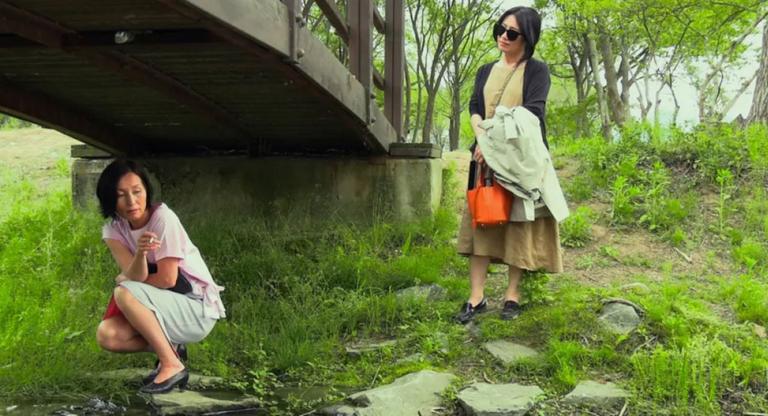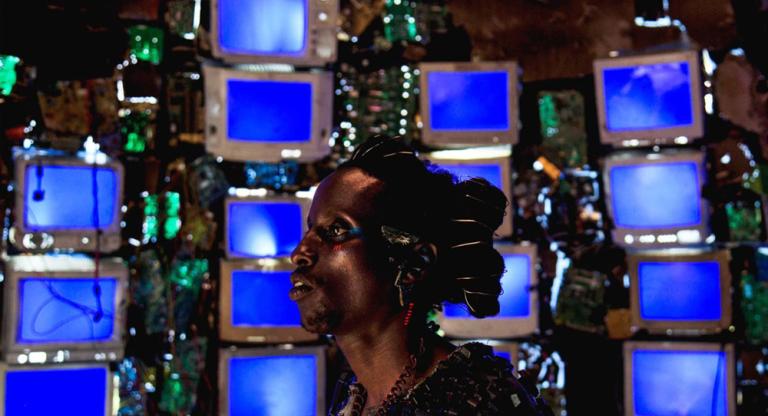The following is the second of three dispatches between Screen Slate writers Jon Dieringer, Maxwell Paparella, and K.F. Watanabe about the 59th New York Film Festival. For reviews of other titles not mentioned below, see our NYFF section.
Jon Dieringer
As the lights dimmed and the titles began for The French Dispatch, it suddenly dawned on me that I was about to watch Wes Anderson’s paean to literary print journalism in a New York auditorium packed with film critics. My heart sank as the person behind me, whom I had overheard say he was attending as the blogger for a free streaming service, laughed at every single cut. Here is someone sitting a typewriter, Here is someone placing pastries on a rotating tray, Here is the exterior of a building with many odd-shaped windows—he gorged on Wes Anderson’s terminal whimsy to the point of asphyxiation as I closed my eyes and wondered if I could will my spirit to exit my body.
The French Dispatch magazine is based in a fictional French city whose name I can’t bring myself to type, and the film is structured as a retelling of three of its essays. I was ultimately swayed by the first one, which features Benicio del Toro as an incarcerated artist who creates abstract paintings with the assistance of his muse and lover, a prison guard played by Léa Seydoux. Compared to the flat, facile artworld critiques of films like Candyman and Velvet Buzzsaw, Anderson has a much more finely attuned sense of the mercurial personalities and motivations driving the art market. The second section, in which a character played by Frances McDormand lectures young leftist activists, including Timothée Chalamet, about moderating their radical beliefs, is obviously garbage, redeemed somewhat only by Algerian actress Lyna Khoudri. Jeffrey Wright also shines in the final story, about a food review that turns into a kidnapping rescue. As much as watching a post-Tenenbaums Wes Anderson film occasionally makes me want to die, I can’t help but admire his formalism and practical effects; ultimately, The French Dispatch is a better tribute to Georges Méliès and Karel Zeman than The New Yorker. Whether due to or in inspite of his twee, cloyingly erudite bullshit, Anderson is capable of reminding the audience of why movies are good and should probably continue to exist.

The seventh art is also venerated by Todd Haynes’s The Velvet Underground, a portrait of the greatest rock band, which takes pains to situate them in the context of New York city’s avant-garde film, art, and music scenes. Employing a great deal of footage of experimental film and video art (provided by archivists who are mostly not thanked by name in the credits—bummer!), Haynes takes pains to establish the cultural conditions of New York City—La Monte Young’s Dream Syndicate, the New American Cinema Group of Jonas Mekas, to whom the film is dedicated, and of course Andy Warhol’s Factory—that made The Velvet Underground possible and distinct from its West Coast rivals (Frank Zappa, boooo). The talking head interviews shot by Ed Lachman consist only of people “who were there,” as Haynes said, including band members John Cale and Maureen Tucker, Factory girl/touring performance member Mary Woronov, obsessive fan Jonathan Richman (delivering illustrated guitar lectures in full Dan Smith mode), Young and Marian Zazeela, and our greatest critic, Amy Taubin, whose testimony includes first-hand accounting of the pre-Velvet band The Primitives featuring Cale, Lou Reed, Tony Conrad, Walter De Maria. Critically, Taubin is also able to deflate some of the mystique around The Factory, describing the anxiety of existing in a space in which people were largely valued for their appearances. For better or worse, the documentary labors over the period surrounding The Velvet Underground and Nico, then speeds through the post-Cale history, neither interviewing Doug Yule nor even hinting at the existence of the fifth and final (if only nominal) Velvet Underground album Squeeze. It’s most effective as a portrait of some of our favorite people in the world’s greatest city in the span of a few fertile years.
I otherwise failed to take in anything from the festival this week, although I did see Ryusuke Hamaguchi at the Screen Slate party (nbd) and caught Jane Campion’s Q&A with David Schwartz alongside a 35mm screening of The Piano at the Paris Theater. Taking into the account all the incredible screenings happening outside the festival, it’s finally starting to feel like things are “back.”
K. F. Watanabe
Jon, I laughed out loud more than once reading your experience of watching The French Dispatch. I have to admit, I’m something of a Wes Anderson apologist among my peers, but I would have reacted the exact same way if I was sitting where you were for that press screening. So I’m glad that I decided to sit that screening out and wait for another opportunity to see it and other marquee Spotlight titles when they get released. Lots of stuff screening now or coming out soon—it does feel like things are “back,” regarding movies at least.
Despite my best intentions, I only managed to make a couple of trips to Lincoln Center for press screenings this week and had to depend on online screeners to watch some films. What I did get to watch on the big screen, however, are among my favorite films in the festival so far. I already wrote about one of them, Hong Sangsoo’s In Front of Your Face, though I’m dissatisfied with the review since I don’t really think I addressed what’s special about it. (I’ve found that the more I like a film, the harder it is for me to write about it—my enthusiasm often outweighs the word count and my own writing ability.) Perhaps more than any other film I’ve seen so far, I had a chance to briefly talk about In Front of Your Face with friends and colleagues, all of whom had about the same consensus as I had upon exiting the Walter Reade Theater: Hong pulled off something really special with this one.
I didn’t get to talk to anyone about Introduction yet, though, Hong’s other film in the festival and winner of Best Screenplay at this year’s Berlinale. Shot in black-and-white (by Hong, working as his own cinematographer for the first time), the film is another character study with a non-traditional narrative structure that, by its end, hits deeper than expected. There are three sections, all revolving around a young man (Shin Seuk-ho) in the early part of adulthood. He travels to Berlin to see his girlfriend—who moved there to study fashion and is equally unsure about her future—and is later introduced by his mother to a famous stage actor who verbally excoriates him while drinking too much soju. I enjoyed it quite a bit, especially its blessed 66-minute runtime, though it might ultimately be considered a minor Hong. But I’ll take a minor Hong over most festival fare any day.
Going back to In Front of Your Face for a moment, a friend mentioned to me how it was a film that would probably work just as well on the small screen and that it did not really require “the big screen experience.” This was not a diss (she liked the film), but a comment on how the film’s strengths are not in the images in themselves—which are not particularly beautiful and do not require a large image to take in—but on how he makes use of them in a cinematic way. This echoed a thought I was turning over in my mind after speaking with another friend about her thoughts on Ryusuke Hamaguchi’s Drive My Car, which she found disappointing: “Did you see any cinematic moments in [the film]? I did not.” She thought the film relied too heavily on its script and did not benefit from being adapted from its literary source into moving images. I don’t quite agree, but it did bring to mind some fundamental questions about cinema I hadn’t thought about in a while.
These thoughts came back when I watched Hamaguchi’s Silver Bear-winning Wheel of Fortune and Fantasy, which is quite different from Drive My Car. A triptych of standalone shorts united by general themes of chance and new starts, all centering on female characters at pivotal moments in their lives, Wheel finds Hamaguchi operating in a looser, lighter, less glossy style more akin to the acting workshop filmmaking that produced Happy Hour (2015). The stories are simple but consistently surprising, layered with emotional insights about love, regret, and self-fulfillment: a forthright young woman realizes her friend is starting a relationship with her ex; an unsentimental student attempts to seduce a recent Akutagawa Prize–winning professor in order to ruin his reputation; and a recently unemployed IT worker runs into who she believes is a former high school lover.
Like Hong’s films, Wheel of Fortune and Fantasy is full of ideas and manages to do a lot with very little. It also plays to one of Hamaguchi’s greatest strengths as a filmmaker, which is creating memorable set pieces generated from interpersonal dynamics and characters actively listening and reacting to each other (I’m thinking particularly of the confession game played in Passion [2008], or the awkward dinner party turned into acting critique in Asako I & II [2018]). Is the film more “cinematic” than Drive My Car? I’m not so sure, but I appreciated Wheel more and felt it made a stronger case for Hamaguchi as an exceptional talent who has hit his stride. I suspect, like the Hong, it would work just as well on the small screen. I’ll have to ask my critical friend what she thought.

Lastly, and in a different direction but one that also foregrounds storytelling through distinct chapters, there is The Tale of King Crab, which I wish I did get to see on the big screen. Directed by Alessio Rigo de Righi and Matteo Zoppis, who previously only made documentaries (that I haven’t seen), it is a diptych centered on a bearded drunkard (Gabriele Silli) in 19th-century Italy who falls in love with the wrong woman, antagonizes a prince, and is banished to the remote archipelago of Tierra del Fuego in Argentina where he seeks a mythical treasure by using a bright red king crab as a compass. The second half was more interesting to me, at times recalling dream-like period films such as Jauja (2014) and Zama (2017) in its evocation of a man caught wandering a liminal landscape with violent undercurrents in search of something beyond his grasp. It also brought to mind The Treasure of the Sierra Madre (1948) in a more literal way, when the quest for gold turns murderous among its ragged seekers, which is very much my speed. It requires a little patience, especially in the first half, but the impressive photography (shot on 35mm) and lulling atmosphere of green Italian countryside carries a lot of weight in pulling you in and setting the mood. Its theatrical release is forthcoming through Oscilloscope.
Still a bit left for me to see, including some Currents shorts and restored Revivals that look excellent, so I hope to do a bit of catchup.
P.S. A belated message of solidarity for Film at Lincoln Center cinema workers who are fighting for a fair deal through Local 2110! Movie culture does not exist without them and they deserve the basic dignity of healthcare and a living wage for their often thankless labor.
Maxwell Paparella
I’ll use my space this week to report back from Sunday's "Cinema's Workers" panel, a free event in the Elinor Bunin Monroe Center atrium. The speakers were Abby Sun, a film programmer and researcher; Ted Fendt, a filmmaker whose Outside Noise played the Currents slate this year, and who used to work as a projectionist for FLC; Kazembe Balagun, a civic educator with Rosa Luxemburg Stiftung's New York office; and Dana Kopel, an OPEIU Local 153 organizer, formerly an editor and unionist at the New Museum. The event was moderated by Gina Telaroli, a program advisor for the festival. Their wide-ranging conversation hacked away at the many-headed hydra of cultural labor and equity, revealing a certain amount of disparity—but also intersections—among the various positions represented.
Telaroli began with a note of solidarity for IATSE, which remains on the verge of a historic strike authorization vote. She proceeded to articulate a sort of solidarity gap in the striving class, in which we will listen to a friend complain about awful working conditions for years, congratulate them when they finally quit, and immediately apply for the position they've left. "How do we stop competing and start cooperating?" she asked.
Sun observed that film societies have traditionally been "oppositional, grassroots, projects." (Film at Lincoln Center dropped the “Society” from its name in 2019, though it continues to operate on a membership model.) Indeed, there is a long history of militant organizing throughout the motion picture arts, from snout to tail. “Rappers want to become actors," Balagun half-kidded, "because the film industry was organized by the left, and the music industry was organized by gangsters.”

Kopel highlighted the plight of workers at Film at Lincoln Center, some of whom are being paid just $15.50 an hour, without benefits. The entire culture industry, Kopel said, relies on being able to "pay people very little to work them to the bone." Fendt admitted that it is far easier to find people in the US who were willing to work for "a symbolic amount of money" than it is in Europe, where he made his most recent film, and where workers have come to expect the rates guaranteed them by industry-wide unions.
Balagun spoke of equity for audiences, as well, bemoaning the fact that just two movie theaters exist in all of the Bronx. What if Netflix was made to give 15% of their profits to fund something like Kanopy?, he asked, referring to the cable access model. Kanopy is a private company, Sun reminded us, whose business model involves extorting the coffers of our public libraries and universities (New York, Queens, and Brooklyn discontinued their contract with the streaming service in 2019 citing "unsustainable" costs). Still, we need models for sustainable production and viewership. Alternative TV infrastructure itself is eroding, Sun reported, with cable companies lobbying for regulation rollbacks in state legislatures.
“We’re in a million dollar facility, but this is probably a thousand-dollar panel,” speculated Balagun. In fact, the Elinor Bunin Monroe Film Center cost many times that, and each speaker on the panel was being paid only $100 for their participation, so it was more like a $400 panel in a $41 million facility. The workers who had taken our tickets were volunteers, as Sun pointed out, trading their labor for access to the exorbitantly priced festival. “This is creating value for Film at Lincoln Center," Sun noted, "right now, everything that we’re doing.” (So, it should be said, are these reviews and dispatches.)
The panel ended, as these things often do, with the question of What Do We Do Now. “Make smaller movies,” Fendt offered. Balagun spoke of decommodifying cinema's means of production and making our moving image archives accessible, but also of a right to the city, the need for an affordability mandate in housing stock, transportation, and otherwise. "Don't be afraid," Sun advised, about coming forward with grievance and working to make change. “Organizing is lifetime work,” Kopel said, “The things we’re working for, I’m not going to see in my lifetime.”






